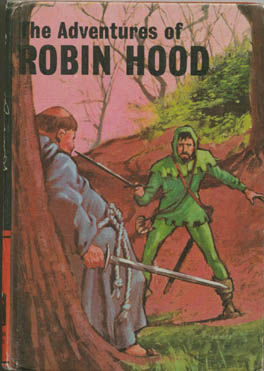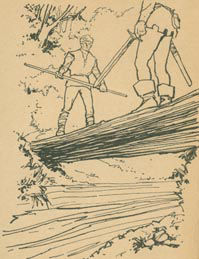Summary of the Book
The first chapter begins with the elopement of the half-Saxon, half-Norman William Fitzooth and Joanna, daughter of Sir George Gamwell (whose family troubles, the great time waster of many a Robin Hood book are thankfully not recounted here). The happy couple have a son named Robert Fitzooth, called Robin Hood by his grandfather. Then the action jumps to Robin's adulthood. Robin's support of King Richard and interfering ways offend Jeremy Cramp and the Sheriff of Nottingham. So, Robin the earl of Huntingdon is outlawed at his wedding to Marion Fitzwalter.
The newly-proclaimed outlaw heads to Sherwood Forest, along with Marion and Will Scarlet. They assemble a band to steal from the rich tax gatherers and give to the poor. Among those who join the Merry Men are John Little, Friar Michael Tuck, Martin Much, Allan-A-Dale and his bride Lorna Demaine, George-A-Green and his wife Betriss, the magician Wellenough and Rough the Woodsman. In meeting Rough, Robin gains a magical horn to summon his outlaw companions. Later, Robin encounters Blondel, King Richard's minstrel. King Richard has been imprisoned in Austria and is being held for ransom. Robin helps to raise the ransom and thwart Prince John's plans for the throne.
Besides Prince John and the sheriff, our heroes face the evil Bishop of Peterborough, Worman -- formerly a servant of Robin's now working for the bishop --, a witch, Desmond of Gisborne and his worst of all, Desmond's cousin Sir Guy of Gisborne. Gisborne leads an ambush which kills several of the Merry Men, including Will Scarlet. In retaliation, Robin beheads Gisborne and kills the sheriff.
Robin also participates in an archery competition at Ashby-De-La-Zouche, where he encounters (in crossover cameos from a fellow Bancroft Classic) Sir Wilfred of Ivanhoe, Sir Brian Bois-Gilbert and the Black Knight, who is secretly King Richard. Richard is restored to his throne and all is made right -- for a while. While Robin and Marion stay in England to have five children, many of the outlaws join Richard in France. Eventually, Richard is killed and John takes the throne. Then, as in the old ballads, Robin is wounded and taken to Kirkleys Priory to be healed. The prioress betrays Robin and he dies, firing a final arrow to mark his grave.
Many years later, the new king Henry III meets Friar Tuck who tells him how Marion became the new Prioress after the evil one's death, Little John went to Ireland and then returned to die in Hathersage. Tuck says "There is one good thing about this old world of ours. No matter who you lose in death, there is always somebody else coming along to be loved. Robin's children, and now a new young King, for example." Henry promises to visit Tuck again.


Contact Us